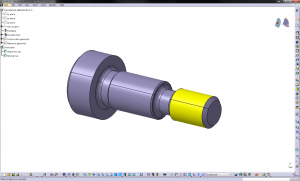
Why Use Publications?
Many parts contain important features that the designer knows will be used in other parts, or to constrain the part in an assembly, such as hole centrelines, mating faces etc… There are three problems with this however:
1) Important features are often hidden amongst large numbers of construction features that are of no interest to other users.
2) There is often multiple ways of defining the same feature when creating constraints and importing part geometry.
3) Similar features in similar parts may be modelled in a completely different manner. Meaning that replacing one part for a similar part will often cause links to it to fail.
For example, consider this shoulder bolt:
To define the centreline, any of the cylindrical features could be selected, the original axis of the revolved section could be used or a new line could be constructed. This means that when this bolt is positioned in an assembly, any combination of these features could be used to define how it interfaces with the assembly. This in turn means that when the Bolt is modified, there is no easy way to predict how this will affect the assembly constraints, particularly if the feature that is being used is replaced in the model. And the problem will only be identified when the assembly (or assemblies) are updated and the links checked.
Features of the 3 other parts all point to different features on the bolt for their assembly constraints
To avoid this problem, a publication can be used to declare the centreline, and this publication used whenever a constraint is made to the centreline. This means that if the published feature is removed or replaced, CATIA will immediately inform the user that the publication no longer points to an existing feature. The user can then re-point the publication to a replacement feature and all of the assembly links will automatically be corrected.
Features of the 3 other parts all point to the publication which defines the centreline
Furthermore, if the Bolt is replaced with another bolt with publications of the same name, then all of the links will automatically update and relink to the replacement bolt’s publications. This is particularly helpful when replacing large numbers of instances.
It should be apparent that, even in this simple example, significant time can be saved by keeping links tidy when managing the creation of an assembly.
CATIA offers a complete engineering toolset within a single working environment and a seamless and consistent user interface. Discover the features and options available for CATIA software.




